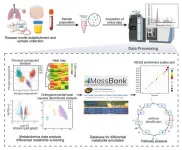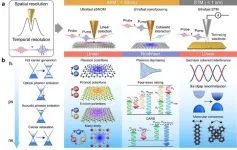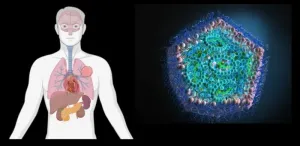(Press-News.org) Researchers have discovered what may be the world’s oldest three-dimensional map, located within a quartzitic sandstone megaclast in the Paris Basin.
The Ségognole 3 rock shelter, known since the 1980s for its artistic engravings of two horses in a Late Palaeolithic style on either side of a female pubic figuration, has now been revealed to contain a miniature representation of the surrounding landscape.
Dr Anthony Milnes from the University of Adelaide’s School of Physics, Chemistry and Earth Sciences, participated in the research led by Dr Médard Thiry from the Mines Paris – PSL Centre of Geosciences.
Dr Thiry’s earlier research, following his first visit to the site in 2017, established that Palaeolithic people had “worked” the sandstone in a way that mirrored the female form, and opened fractures for infiltrating water into the sandstone that nourished an outflow at the base of the pelvic triangle.
New research suggests that part of the floor of the sandstone shelter which was shaped and adapted by Palaeolithic people around 13,000 years ago was modelled to reflect the region’s natural water flows and geomorphological features.
“What we’ve described is not a map as we understand it today — with distances, directions, and travel times — but rather a three-dimensional miniature depicting the functioning of a landscape, with runoff from highlands into streams and rivers, the convergence of valleys, and the downstream formation of lakes and swamps,” Dr Milnes explains.
“For Palaeolithic peoples, the direction of water flows and the recognition of landscape features were likely more important than modern concepts like distance and time.
“Our study demonstrates that human modifications to the hydraulic behaviour in and around the shelter extended to modelling natural water flows in the landscape in the region around the rock shelter. These are exceptional findings and clearly show the mental capacity, imagination and engineering capability of our distant ancestors.”
Thanks to his extensive research on the origins of Fontainebleau sandstone, Dr Thiry recognised several fine-scale morphological features that could not have formed naturally, suggesting they were modified by early humans.
“Our research showed that Palaeolithic humans sculpted the sandstone to promote specific flow paths for infiltrating and directing rainwater which is something that had never been recognised by archaeologists,” Thiry says.
“The fittings probably have a much deeper, mythical meaning, related to water. The two hydraulic installations — that of the sexual figuration and that of the miniature landscape — are two to three metres from each other and are sure to relay a profound meaning of conception of life and nature, which will never be accessible to us.”
Milnes and Thiry’s latest study, published in Oxford Journal of Archaeology, discovered the presence of three-dimensional modelling by closely examining fine-scale geomorphological features.
“This completely new discovery offers a better understanding and insight into the capacity of these early humans,” Thiry says.
Before this discovery, the oldest known three-dimensional map was understood to be a large portable rock slab engraved by people of the Bronze Age around 3000 years ago. This map depicted a local river network and earth mounds, reflecting a more modern map concept used for navigation.
Dr Milnes says that collaborating across disciplines — such as archaeology, geology and geomorphology — is vital in science.
“We believe the most productive research outcomes are found at the boundaries between disciplines,” Dr Milnes says.
“Re-evaluating field studies and conducting frequent site visits are important. It’s clear from our ongoing project that insights and interpretations do not appear immediately but emerge through new observations and interdisciplinary discussions,” Dr Thiry suggests.
END
World’s oldest 3D map discovered
Researchers have discovered what may be the world’s oldest three-dimensional map, located within a quartzitic sandstone megaclast in the Paris Basin.
2025-01-14
ELSE PRESS RELEASES FROM THIS DATE:
Metabolomics-driven approaches for identifying therapeutic targets in drug discovery
2025-01-14
This review is led by Professor. Tengfei Xu (Research Center for Clinical Pharmacy, College of Pharmaceutical Sciences, Zhejiang University) and Professor. Su Zeng (Research Center for Clinical Pharmacy, College of Pharmaceutical Sciences, Zhejiang University). The author emphasizes metabolomics’ critical role in advancing our understanding of disease mechanisms and accelerating targeted drug development, while acknowledging current challenges in the field.
Metabolomics, as a powerful tool, can captures phenotypic changes induced by exogenous compounds, offering a valuable ...
Applications of ultrafast nano-spectroscopy and nano-imaging
2025-01-14
Optical microscopy has long been a fundamental tool for scientific discovery. Yet, traditional far-field techniques are limited by diffraction, restricting their resolution to hundreds of nanometers, which can be inadequate for capturing phenomena in quantum and solid-state materials. With the emergence of tip-based microscopy capable of achieving atomic-scale spatial resolution, near-field optical nano-spectroscopy and nano-imaging have evolved into versatile tools for characterizing the optical properties of materials at the nanoscale. When further combined with ultrafast pump-probe ...
Study links PFAS contamination of drinking water to a range of rare cancers
2025-01-14
Communities exposed to drinking water contaminated with manufactured chemicals known as per- and polyfluoroalkyl substances (PFAS) experience up to a 33% higher incidence of certain cancers, according to new research from the Keck School of Medicine of USC.
The study, funded by the National Institutes of Health and just published in the Journal of Exposure Science and Environmental Epidemiology, is the first to examine cancer and PFAS contamination of drinking water in the U.S.
PFAS, which are used in consumer products such as furniture and food packaging, have been found in about 45% of drinking water supplies across the United States. ...
Scientists explain how a compound from sea sponge exerts its biological effects
2025-01-14
Girolline, a compound extracted from the sea sponge Pseudaxinyssa cantharella, has been investigated for possible antitumor effects and also found to have anti-malarial effects. Now, thanks to work by scientists from the RIKEN Center for Sustainable Resource Science, researchers have a better idea of how it works. In addition to its possible medicinal properties, the current findings suggest that the compound could also be useful as a chemical probe for research in areas such as aging and mitochondrial health.
GIrolline is one of a number of compounds with biological functions that were isolated from Pseudaxinyssa ...
Why older women are embracing the open road
2025-01-14
Older Australian women are challenging traditional views of aging, embarking on solo road trips and travelling the country in search of adventure, personal growth and new horizons.
Equipped with a caravan, campervan, or a sturdy 4WD and a tent, these women are navigating vast landscapes, from the dusty Oodnadatta Track to the spectacular Tasmanian wilderness.
Margaret Yates, a PhD candidate from the University of Technology Sydney (UTS) Faculty of Health and a retired nurse, interviewed 29 women travellers to explore their motivations and experiences. The majority were over sixty and considered themselves ...
Shift to less reliable ‘natural’ contraception methods among abortion patients over past 5 years
2025-01-14
There has been a shift away from the use of more reliable hormonal methods of contraception to less reliable fertility awareness methods among women requesting abortion in England and Wales over the past 5 years, reveals research published online in the journal BMJ Sexual & Reproductive Health.
Use of the Pill, mini Pill, implants, patches, and vaginal rings has given way to more ‘natural’ methods, such as period tracking apps that highlight monthly peak fertility/ovulation, the findings ...
Tobacco advertising + sponsorship bans linked to 20% lower odds of smoking
2025-01-14
Implementing bans on the advertising, promotion, and sponsorship of tobacco products is linked to 20% lower odds of smoking, and 37% lower risk of taking up the habit, reveals a pooled data analysis of the available research, published online in Tobacco Control.
The findings indicate that these bans do influence behaviour, lending further weight to calls for their wider international implementation and enforcement, conclude the researchers.
In 2019 alone, more than a billion people around the globe regularly smoked tobacco, and smoking caused nearly 8 million deaths, note the researchers.
To curb the toll ...
Vascular ‘fingerprint’ at the back of the eye can accurately predict stroke risk
2025-01-14
A vascular ‘fingerprint’ on the light sensitive tissue layer at the back of the eye—the retina—can predict a person’s risk of stroke as accurately as traditional risk factors alone, but without the need for multiple invasive lab tests, finds research published online in the journal Heart.
The fingerprint, comprising 29 indicators of vascular health, is a practical and readily implementable approach that is particularly well suited for primary healthcare and low-resource settings, conclude the researchers.
Stroke affects around 100 million people around the globe and ...
Circulation problems in the brain’s seat of memory linked to mild cognitive impairment in older adults
2025-01-14
Mild cognitive impairment is linked to blood vessel dysfunction in the brain’s temporal lobes — the seat of memory — according to a new USC-led study.
The findings, seen in people with and without signs of amyloid buildup in the brain, suggest that microvascular trouble may be an important, early biomarker for dementia as well as a potential target for therapy.
The research, involving scientists from multiple universities, appears in the journal Neurology.
“We’re studying ...
Oregon State receives $11.9 million from Defense Department to enhance health of armed forces
2025-01-13
PORTLAND, Ore. – The U.S. Department of Defense has awarded up to $11.9 million to Oregon State University to invent new drug delivery technologies for protecting members of the military from a range of health threats in combat areas.
Once designed, developed and tested, the technologies could also be applied as needed within the general public, said OSU College of Pharmacy nanomedicine researcher Gaurav Sahay, the project leader.
The award comes from the Defense Advanced Research Projects Agency through its Hermes program, whose goal is finding new ways to deliver therapeutic agents throughout the body with exceptional ...
LAST 30 PRESS RELEASES:
House sparrows in northern Norway can help us save other endangered animals
Crohn's & Colitis Foundation survey reveals more than 1/3 of young adults with IBD face step therapy insurance barriers
Tethered UAV autonomous knotting on environmental structures for transport
Decentralized social media platforms unlock authentic consumer feedback
American Pediatric Society announces Vanderbilt University School of Medicine as host institution for APS Howland Visiting Professor Program
Scientists discover first method to safely back up quantum information
A role for orange pigments in birds and human redheads
Pathways to net-zero greenhouse gas emissions for Southeast Asia
A JBNU–KIMS collaborative study on a cost-effective alloy matches superalloys for power plants and energy infrastructure
New study overturns long-held model of how plants coordinate immune responses.
New AI model predicts disease risk while you sleep
Scientists discover molecular ‘reshuffle’ and crack an 80-year-old conundrum
How stressors during pregnancy impact the developing fetal brain
Electrons lag behind the nucleus
From fungi to brain cells: one scientist's winding path reveals how epigenomics shapes neural destiny
Schizophrenia and osteoporosis share 195 genetic loci, highlighting unexpected biological bridges between brain and bone
Schizophrenia-linked genetic variant renders key brain receptor completely unresponsive to both natural and therapeutic compounds
Innovative review reveals overlooked complexity in cellular energy sensor's dual roles in Alzheimer's disease
Autism research reframed: Why heterogeneity is the data, not the noise
Brazil's genetic treasure trove: supercentenarians reveal secrets of extreme human longevity
The (metabolic) cost of life
CFRI special issue call for papers: New Frontiers in Sustainable Finance
HKU Engineering scholar demonstrates the smallest all-printed infrared photodetectors to date
Precision empowerment for brain "eavesdropping": CAS team develops triple-electrode integrated functional electrode for simultaneous monitoring of neural signals and chemical transmitters during sleep
Single-capillary endothelial dysfunction resolved by optoacoustic mesoscopy
HKU three research projects named among ‘Top 10 Innovation & Technology News in Hong Kong 2025’ showcasing excellence in research and technology transfer
NLRSeek: A reannotation-based pipeline for mining missing NLR genes in sequenced genomes
A strand and whole genome duplication–aware collinear gene identification tool
Light storage in light cages: A revolutionary approach to on-chip quantum memories
Point spread function decoupling in computational fluorescence microscopy
[Press-News.org] World’s oldest 3D map discoveredResearchers have discovered what may be the world’s oldest three-dimensional map, located within a quartzitic sandstone megaclast in the Paris Basin.




